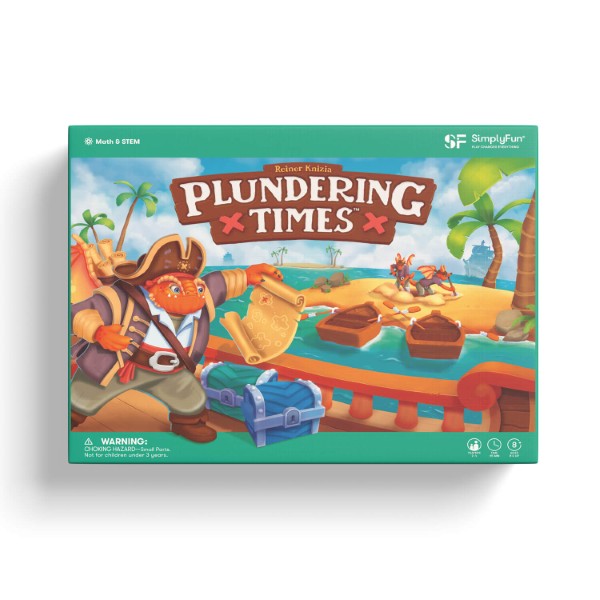
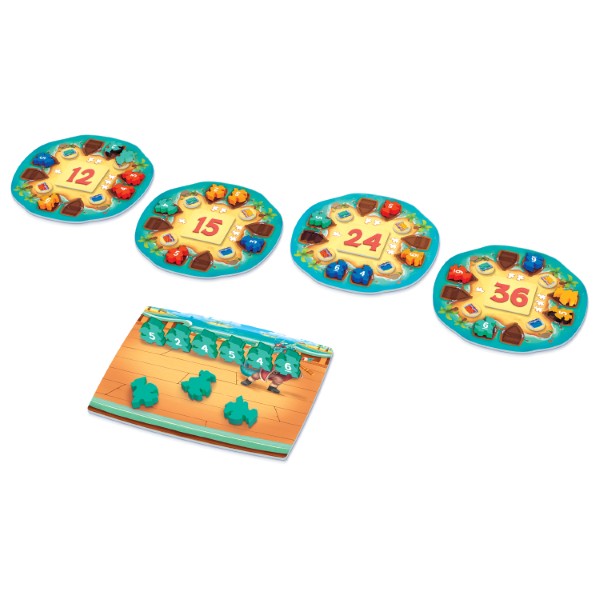
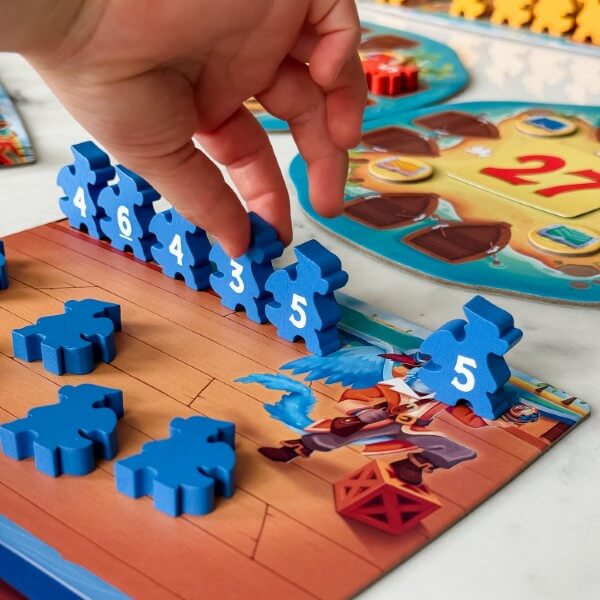
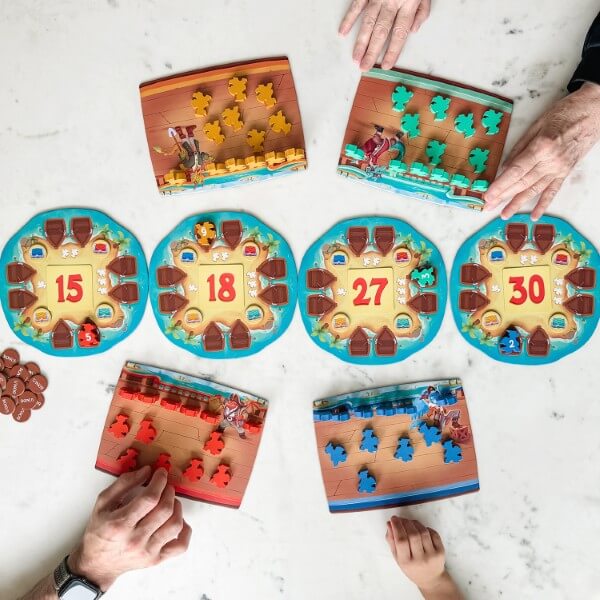
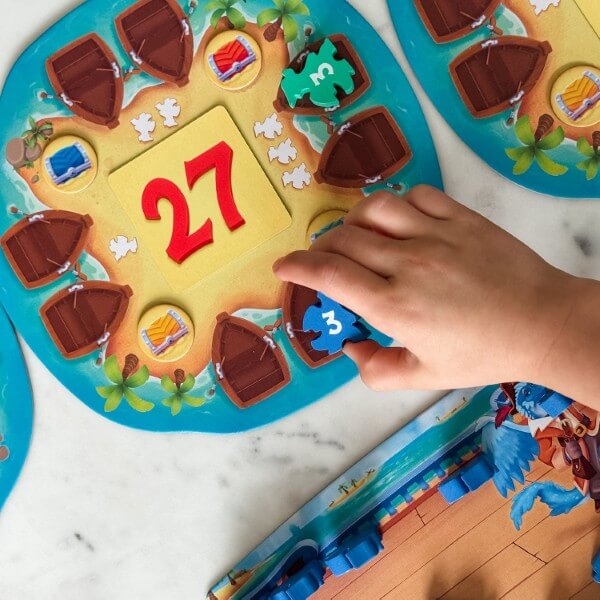
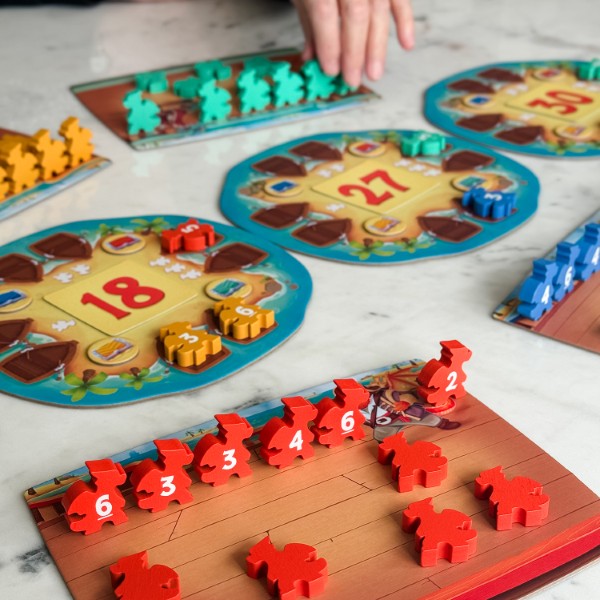
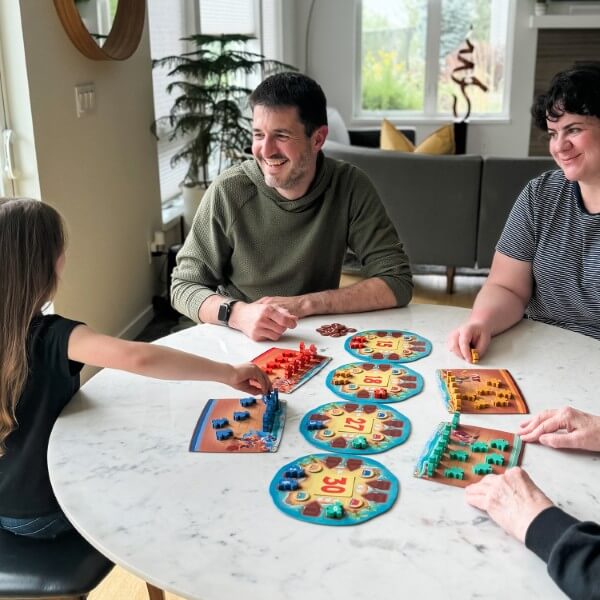
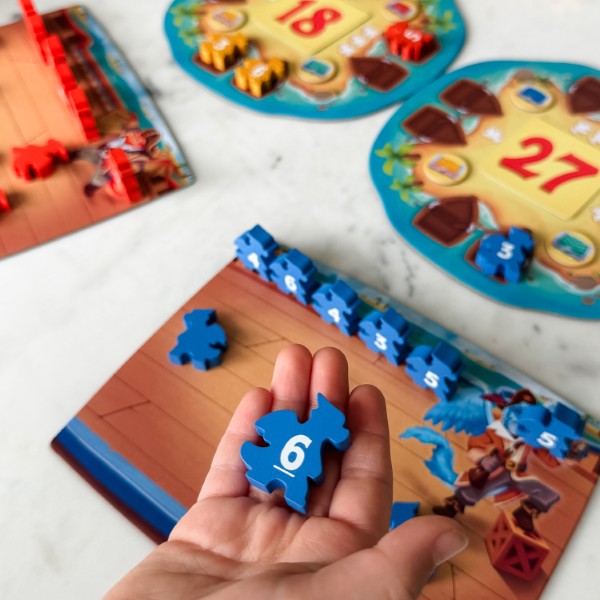
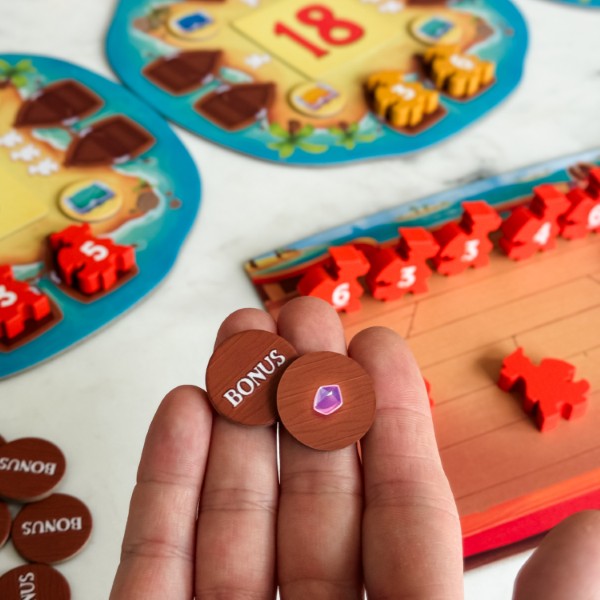
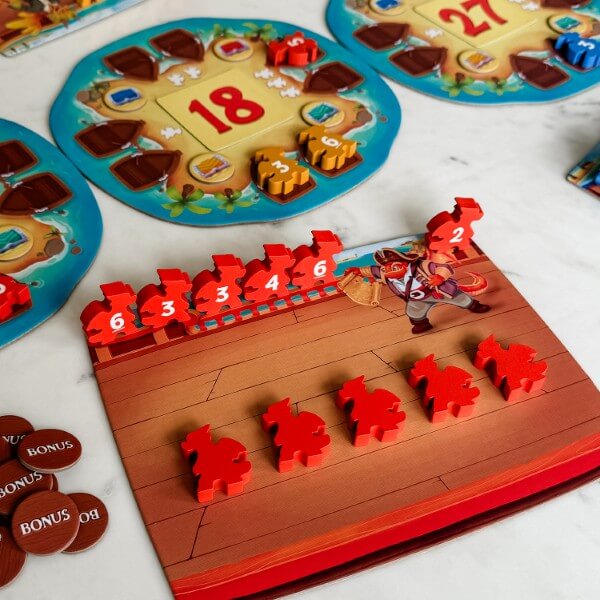
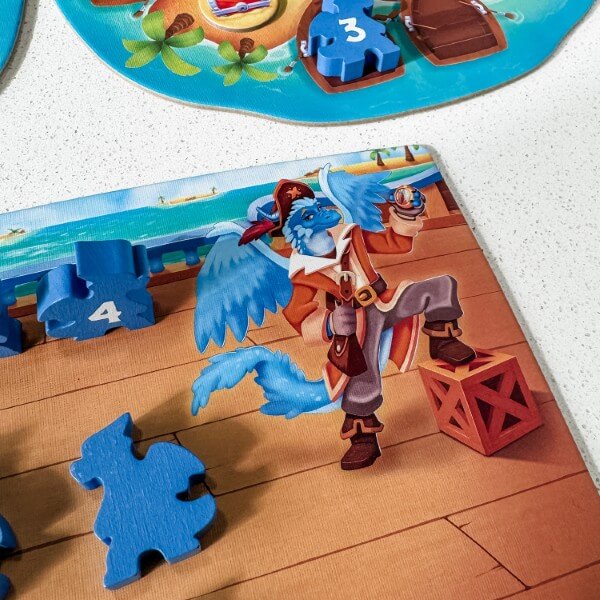






Collapsible content
A game where players raid the various Islands of Numbers for the shiniest treasure! You can play Plundering Times with 2-4 players, ages 8 and up!
Plundering Times is great for developing Multiplication and Addition skills as Players creatively place their dragon pirates so that the values multiplied and added equate as closely as possible to the number on the island without going over.
Plundering Times also helps develop Memory skills as each player needs to think ahead about the best place to hide their treasure chests and then remember where they placed them while making multiple calculations throughout the game. Place the four treasure islands in the play area, making sure the white dragon icons are in the same orientation across all islands.
For basic gameplay, pull out the 10 smaller island number cards (teal backs). Shuffle them and randomly select four cards to be placed in numerical order on each island, covering the red X in the middle.
Give each player a matching color set of dragon pirates, treasure chests and a captain board.
Have each player take their 14 lower-valued dragon pirates (numbered 2–6) and place them, number side down, anywhere on their captain board. Place the remaining dragon pirates back in the box.
This video covers basic gameplay. If you want to try the advanced game, gameplay will be the same, but you will use all the island number cards and all the dragons for more complex multiplication.
Next, have each player randomly choose six of their dragon pirates and stand them up on their captain board so the other players cannot see their number values.
Each island has four circular spaces. Place one of your treasure chests onto one of these spaces on each island with the gem side face down. Each island should have one treasure chest from every player. Remember where you placed your gems—at the end of the game, you may be able to pick up another player’s treasure chest instead of your lower-valued ones.
Place the bonus gem tokens to the side for now, using the chart below. Place any remaining tokens back in the box.
The first player to name a famous captain starts the game.
Captains try to get the closest answer to the island numbers by placing two dragon pirates on each island and multiplying their number values (and possibly adding to the result depending on which side you place your dragon pirates). The closer your answer is to the number on the island (without going over), the earlier you get to pick a treasure chest on that island and the opportunity to plunder your opponent's most valuable gems! Get an exact answer and earn a bonus gem. The captain who has plundered the most gems wins!
PAIRING DRAGON PIRATES
On your turn, choose any one of the island values you want to try to solve. Next, select one of your standing dragon pirates from your captain board and place it on one of the rowboats alongside that island so that all players can see its value (A).
If this is your first dragon pirate on an island, you may choose any free side that does not yet have a placed dragon. By placing it, you have claimed that side of the island, and no other players may place dragon pirates on that side of that island (B).
When placing your second dragon pirate on an island, you must place it next to your first, in the remaining empty rowboat (C). You can also choose to place single dragon pirates on different islands before going back to place a second.
You can never have more than two of your dragon pirates on an island.
Remember, the goal is to multiply the values on your two dragon pirates and add any dragon icons to produce an answer that equals or comes closest to the number on the island without going over.
USING DRAGON ICONS
Each island has dragon icons on three of its sides that help a player get closer to or equal the island number by adding the number of icons to their pair of dragon pirates. The dragon icons are not optional and must be added to your answer. Remember this when placing and pairing your dragon pirates to avoid going over the island number.
One Dragon Icon—Adds 1 to your multiplied total.
Two Dragon Icons—Adds 2 to your multiplied total.
Three Dragon Icons—Adds 3 to your multiplied total.
No Dragon Icons—Adds nothing to your multiplied total.
After you've placed a dragon pirate on an island, select one of your face down dragons and stand it up so that you have six dragon pirates standing in front of you again. Now it's the next player's turn. Gameplay proceeds clockwise.
Once all players have placed two dragons on each island, it is time to start scoring. Score the islands in Numerical order. Multiply each player’s pair of dragon pirates on each island and add any additional dragon pirate icons on that same side. This is the player’s answer and determines the order in which to pick treasure chests from that island.
End of Game
The game ends when all players have placed two of their dragon pirates on all four of the islands.
Scoring Score each island after the game ends to find
out which dragon pirates dug the closest to the treasure chests!
If needed, flip over your captain board to help check your multiplication using the times table.
CHOOSE A TREASURE CHEST
The player whose dragon pirate pair equals the island number or comes closest to it picks their treasure chest first, then the player with the next closest answer picks, and so on.
If some players have the same answer, the player who placed the dragon pirate with the higher single-number value picks earlier. If the tie persists, the higher of the second number value of the pair decides the order.
If your answer is greater than the island number, you must withdraw your two dragon pirates, and you will not get to pick any treasure chests from this island.
Remember, you can pick any color treasure chest from an island, so consider picking another player's treasure if you think it might contain more gems!
After picking, reveal the hidden gems to all the players, and keep this treasure chest in front of you. This gem’s value is now yours!
BONUS If your answer equals the island number exactly, you receive a bonus gem token. Multiplication with the help of dragon icons can count as getting an exact answer. Bonus gem tokens add one extra gem to your total. Multiple players can receive a bonus gem token per island, and each player can earn up to a total of four bonus gem tokens.
EXAMPLE Orange and blue both have an answer of 15, matching the island number:
3 x 5 = 15 and 2 x 6 + 3 = 15. Blue played the higher single-number value dragon pirate (6) and is first to pick a treasure chest. Orange picks next.
Orange and blue also each earn a bonus gem (see the Bonus section on the next page). Yellow has an answer of 3 x 4 + 1 = 13 and picks next. Teal has an answer of 4 x 4 + 2 = 18, which is greater than the island number.
Therefore, teal does not get to pick a treasure chest from this island.
WINNER
When all four islands have been scored, the players count up their gems. The player with the most gems wins! If there is a tie, the tied players become joint winners.
Can you use your savvy multiplication skills to navigate your crew to amass the greatest hoard when you play SimplyFun’s Plundering Times?


Core Standard*: Math
Math
- Operations and Algebraic Thinking
- Represent and solve problems involving multiplication and division. : Grade Level 3rd
- Multiply and divide within 100. : Grade Level 3rd
- Number & Operations in Base 10
- Use place value understanding and properties of operations to perform multi-digit arithmetic. : Grade Level 3rd, 4th

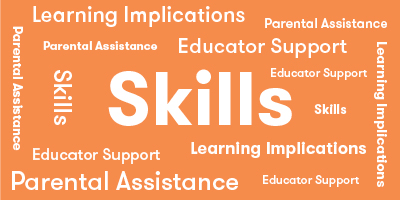
Explore
What Does Child Do To Use Skill In The Game?
Players will build their exploration skills as they look for options to play and pair dragon pirates on the islands.
How Parents Can Assist Learning
Plundering Times involves so much decision making, it may help to encourage children to "Wait. Look. Think." This will help them spend enough time considering options and implications of different possible placements of their dragon pirates.
This will also help with impulsivity and planning. Using such verbal cues can give children a model for approaching future play as well as complex life choices.
Learning Implications and Educator Support
Plundering Times requires ample focus as children examine the different islands to identify the best locations to play their dragon pirates.
The game involves so much decision making, it may help to encourage children to "Wait. Look. Think." This will help them spend enough time considering options and implications of different possible placement of their dragon pirates.
This will also help with impulsivity and planning. Using such verbal cues can give children a model for approaching future play as well as complex life choices.
Determine
What Does Child Do To Use Skill In The Game?
After the exploration of the islands, children compare options and decide where to place a dragon pirate. After all turns are completed, each player goes through a multi-step scoring process to determine their individual scores and who is the winner.
How Parents Can Assist Learning
When learning multiplication, children need to understand that it can be understood as repeated addition. For example, 4 x 3 is the same as adding 4 + 4 + 4. Therefore, parents help their child add sets of numbers in the multiplication operations created by their dragon pirates that are placed on the treasure islands. That will help children understand rather than merely memorize a times table.
Learning Implications and Educator Support
Plundering Times builds children's reasoning and analytical skills, along with multiplication and addition, as they both compare options and decide what move to make on their turn. They need to consider many variables including the desired score on an island, the current and likely scores of other players and the options they have to place dragon pirates on their turn as well as which dragon pirates will remain on their captain board.
Educators may introduce different techniques, such as repeated addition or using the provided times tables, to help children at different levels learn and used multiplication.
Compare
What Does Child Do To Use Skill In The Game?
As players examine the treasure islands, they will analyze and compare options for where they can place dragon pirates for an optimal score or to set themselves up for future turns.
How Parents Can Assist Learning
Because exploring, determining and comparing are all happening together in this game, the same parental support applies to building the compare skill: it may help to encourage children to "Wait. Look. Think." This will help them spend enough time considering options and implications of different possible placement of their dragon pirates.
This will also help with impulsivity and planning. Using such verbal cues can give children a model for approaching future play as well as complex life choices.
Learning Implications and Educator Support
Plundering Times builds children's reasoning and analytical skills, along with multiplication and addition, as they both compare options and decide what move to make on their turn. They need to consider many variables including the desired score on an island, the current and likely scores of other players and the options they have to place dragon pirates on their turn as well as which dragon pirates will remain on their captain board.
The game involves so much decision making, it may help to encourage children to "Wait. Look. Think." This will help them spend enough time considering options and implications of different possible placement of their dragon pirates.
Remember
What Does Child Do To Use Skill In The Game?
It is helpful to remember the value of the treasure chests you place on islands, as well as to remember multiplication and addition skills.
How Parents Can Assist Learning
If a child needs help with remembering their multiplication, let them use the times table card that is the same color as their dragon pirates during gameplay.
Learning Implications and Educator Support
Plundering Times is a great game for teaching and reinforcing multiplication skills. Educators may introduce different techniques, such as repeated addition or using the provided times tables, to help children at different levels learn and used multiplication.
Predict
What Does Child Do To Use Skill In The Game?
As players place their dragon pirates on treasure islands, the odds of a desired numbered dragon pirate on their captain's board turning up increases. Consequently, they will be better able to use that probability to make decisions on their turn.
How Parents Can Assist Learning
As you play Plundering Times, the probability of a specific numbered dragon pirate being selected to stand up on your captain's board will increase. Children can use this information to think about where to place a dragon pirate on treasure islands during their turn.
Learning Implications and Educator Support
While Plundering Times does not involve a lot of prediction, it does allow for children to think about and consider probability in their decision making.
Educators may want to ask open-ended questions to foster analytical thinking such as "Which numbers on your dragon pirates have you not seen yet?" or "What are the chances that you will pick the numbered dragon pirate you want?"
Plan
What Does Child Do To Use Skill In The Game?
Plundering Times involves a lot of planning as players think about where to place dragon pirates in order to set themselves up for future moves based on numbered dragon pirates they can see and those that are still face down on their captain's board.
How Parents Can Assist Learning
Parents may want to ask questions to help children think through their strategy and planning, such as "Where can you place a dragon pirate so you can multiply it with another of your dragon pirates to equal or get close to the number on the treasure island?" or "What are the scores other players can get on an treasure island and can you do better than that?"
Learning Implications and Educator Support
Plundering Times builds children's planning and sequencing skills, reinforced with analysis, probability and logic, as they decide what move to make on their turn considering how they set themselves up for success in future turn.
Educators may want to ask questions to help children think through their strategy and planning, such as "Where can you place a dragon pirate so you can multiply it with another of your dragon pirates to equal or get close to the number on the treasure island?" or "What are the scores other players can get on an treasure island and can you do better than that?"
Practice
What Does Child Do To Use Skill In The Game?
Playing Plundering Times is a great way to practice and improve multiplication skills.
How Parents Can Assist Learning
When learning multiplication, children need to understand that it can be understood as repeated addition. For example, 4 x 3 is the same as adding 4 + 4 + 4. Therefore, parents help their child add sets of numbers in the multiplication operations created by their dragon pirates that are placed on the treasure islands. That will help children understand rather than merely memorize a times table.
Learning Implications and Educator Support
Plundering Times is a great game for teaching and reinforcing multiplication skills. Educators may introduce different techniques, such as repeated addition or using the provided times tables, to help children at different levels learn and used multiplication.
Solve
What Does Child Do To Use Skill In The Game?
The game area (four treasure islands) changes during play as other players place their dragon pirates, revealing their ability or likelihood to create operations that equal or are close to the target number on the treasure island. This evolving information and changing game area affects the options for a player on their turn.
How Parents Can Assist Learning
Other than encouraging children to take their time to think through the implications of different moves, no special assistance is required.
Learning Implications and Educator Support
Plundering Times is a good way for children to learn how to adapt their thinking to new information and context, which is fundamental to a variety of executive functioning skills.
Educators may want to ask questions to engage children in conversation to reveal their analysis and encourage more consideration of options. For example, "What do you think the other players are trying to achieve?", "Where do you think you can place a dragon pirate so you can get the exact number on the treasure island?" or "Where could you place a dragon pirate to make it harder for another player?"
Review
What Does Child Do To Use Skill In The Game?
The scoring process of Plundering Times involves a lot of review as players need to conduct multiple equations, collect bonus gems and share all the results to determine who won the game.
How Parents Can Assist Learning
No special assistance required.
Learning Implications and Educator Support
No special assistance required.
*Data compiled from CCSSI ELA Standards, WA Science Standards, and Washington Social Studies Standards


Cognitive
Suggestions for How to Modify Play Experience
If the times tables are too difficult to understand, let the child manipulate toothpicks or other small objects. The child can count out number sets for each of the numbers on the pirates (4 X 5 = 11111 + 11111 + 11111 + 11111). This helps them learn that multiplication is actually addition.
Play with a partner, so problem solving is done jointly. The partner can help the child learn by demonstrating how to use the times tables.
Plundering Times may be too difficult for children with cognitive challenges if they cannot count or add numbers.
Communication
Suggestions for How to Modify Play Experience
Children with communication delays should be able to play Plundering Times, as not much communication is required; although talking about each turn should be encouraged. Players can announce the numbers and the products (6 X 4 = 24) and then state what is being added and the total (24+ 3 = 27).
Sensorimotor
Suggestions for How to Modify Play Experience
Players with fine motor control concerns may need help standing up their dragon pirates so they can see the numbers on the pieces. They may also need help placing pieces onto the islands. They can point to the dragon pirates they want to stand up, the two they want selected, and where they want them placed.
Play with a partner. One partner can manipulate the pieces and problem solving can be done jointly.
Social Emotional/Behavioral
Suggestions for How to Modify Play Experience
As long as multiplication is not a frustrating activity, children should be able to play through each round quickly. If frustration occurs, enable the child to use the times tables provided.
Play with a partner, so problem solving is done jointly. This can reduce the stress a player who lack confidence may feel.
Vision
Suggestions for How to Modify Play Experience
Plundering Times is not recommended for person’s with low vision.
Hearing
Suggestions for How to Modify Play Experience
Persons with hearing impairment should be able to play Plundering Times, as no discussion is needed. Reading the rules along with demonstration of game play should enable players to learn the game.
*Data compiled from CCSSI ELA Standards, WA Science Standards, and Washington Social Studies Standards

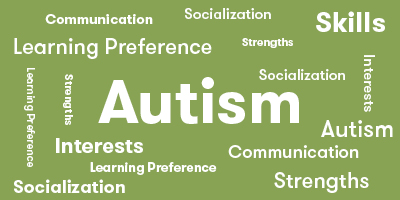
Autism Strengths & Interests
Short Summary of Strengths & Interests
- Multiplication
- Addition
- Nonverbal reasoning
Is good at matching visual items
This game is not appropriate
Has a good memory for sensory details, including visual, touch, taste and smell
This game is not appropriate
Has a good memory for words, phrases and dialouge
This game is not appropriate
Has a good memory for pictures, numbers and patterns
Is This Game Appropriate? Yes
Description
Memory for multiplication facts or ability to add number sets to get a total equal to the multiplication product is needed. A multiplication table is provided to aid players who need it. Players must also remember to allow for adding dragon icons on the island sides.
Likes to put things in order or a sequence
This game is not appropriate
Learns through visualizing or "replaying" actions in their mind
This game is not appropriate
Likes activities with rules, such as math and phonics
Is This Game Appropriate? Yes
Description
Plundering Times is a multiplication and addition game. Players must multiply and add on each turn.
Is very concrete and literal
This game is not appropriate
Learns in small "chunks" (for example, phone numbers are 3 chunks of number xxx-xxx-xxxx that are combined together)
This game is not appropriate
Is good at nonverbal reasoning and logic
Is This Game Appropriate? Yes
Description
Plundering Times requires nonverbal reasoning.
Likes spatial problem solving
This game is not appropriate
Can read well with good vocabulary, though may not fully comprehend content
This game is not appropriate
Likes to use and has good fine motor skill
Is This Game Appropriate? Yes
Description
Fine motor skills are required for setting up the game and for placing the dragon pirates and treasure chests on the islands. This should not, however, limit play, as other players can assist if needed.
Likes established routines or set ways of doing things
Is This Game Appropriate? Yes
Description
Children with autism who like math may like Plundering Times as the multiplication and addition facts do not change and are predictably the same each time.
Likes manipulating, constructing or building things
This game is not appropriate
Likes to use and has good musical abilities
This game is not appropriate
Likes to use and has good drawing skills
This game is not appropriate
Autism Special Considerations
Appears to ignore other's communication and/or has difficulty giving eye contact to a communication partner
Is This Game Appropriate for Child with Characteristic? Yes
Can Child with Characteristic Play Game w/o Modification? Yes
Strategies for Developing Compensatory Skills:
Eye contact and communication is not needed to play Plundering Times. Players can concentrate on studying their options on the treasure islands.
Has difficulty understanding complex verbal directions
Is This Game Appropriate for Child with Characteristic? Yes
Can Child with Characteristic Play Game w/o Modification? No
Strategies for Developing Compensatory Skills:
If language comprehension is an issue for the child, break down the directions and explain the game play one step at a time with demonstration. Have the child show their understanding by practicing each step. Use the pictures in the directions to help clarify.
Uses vocabulary inaccurately or demonstrates echolalia (repeating another's speech)
Is This Game Appropriate for Child with Characteristic? Yes
Can Child with Characteristic Play Game w/o Modification? Yes
Strategies for Developing Compensatory Skills:
Unless the extraneous speech or echolalia hinders the game play of others, it should not be problematic.
Gets stuck repeating a verbal topic or physical actions and/or has difficulty attending to others' actions or topic.
Is This Game Appropriate for Child with Characteristic? Yes
Can Child with Characteristic Play Game w/o Modification? Yes
Strategies for Developing Compensatory Skills:
Watching others' play can help the players be strategic, but players can play successfully without attending to others' actions.
Has difficulty producing speech/communication
Is This Game Appropriate for Child with Characteristic? Yes
Can Child with Characteristic Play Game w/o Modification? Yes
Strategies for Developing Compensatory Skills:
Communicating with others is not needed, but should be encouraged.
Has difficulty sequencing multi-step actions and/or doing complex abstract tasks
Is This Game Appropriate for Child with Characteristic? No
Can Child with Characteristic Play Game w/o Modification? No
Strategies for Developing Compensatory Skills:
Plundering Times requires players to analyze the totals required on each island, then make strategic decisions about which of their pirate dragons can most closely reach those totals. Players need to think not only about the numbers they see on the six visible dragon pirates, but also what is left in their unseen dragon pirates. They also have to take into consideration the dragon pirate icons on the islands that must be added to their multiplication product. If this complex sequence of thinking processes is too difficult for the child, Plundering Times may not be a good choice of game. On the other hand, some children with autism excel with numbers and math, and the game may be a good match for their skills.
Demonstrates difficulty initiating and maintaining social interactions
Is This Game Appropriate for Child with Characteristic? Yes
Can Child with Characteristic Play Game w/o Modification? Yes
Strategies for Developing Compensatory Skills:
Social interactions in Plundering Times can be indirect, with each player attending to their own game board. Discussion, however, should be encouraged.
Acts out or demonstrates avoidance behaviors when frustrated, overwhelmed, or needs more sensory input.
Is This Game Appropriate for Child with Characteristic? No
Can Child with Characteristic Play Game w/o Modification? No
Strategies for Developing Compensatory Skills:
If math is not of interest to the child, Plundering Times is not recommended, as it may be both overwhelming and frustrating. If the child only needs more sensory input to stay attentive, intermittent movement or fidget toys may be introduced.
Has short attention span for non-preferred activities
Is This Game Appropriate for Child with Characteristic? No
Can Child with Characteristic Play Game w/o Modification? No
Strategies for Developing Compensatory Skills:
If math is a nonpreferred activity, Plundering Times may not be a good choice of games. On the other hand, the child enjoys math, this is a good choice.
Needs sameness or consistent routines and/or has difficulty with transitions from one activity to another
Is This Game Appropriate for Child with Characteristic? Yes
Can Child with Characteristic Play Game w/o Modification? Yes
Strategies for Developing Compensatory Skills:
The game process is the same each time; so once the child understands the game sequence, they may feel comfortable with the game play. Allow the child to help set up the game play to aid in transitioning to playing Plundering Times. This will help give them a sense of control over the new situation.
Has difficulty understanding others' feelings, intentions, and the reasons for others' actions.
Is This Game Appropriate for Child with Characteristic? Yes
Can Child with Characteristic Play Game w/o Modification? Yes
Strategies for Developing Compensatory Skills:
Understanding others' feelings is not needed to play the game. However, following and understanding others' intentions with their play may help the child strategize what to play.
*Data compiled from CCSSI ELA Standards, WA Science Standards, and Washington Social Studies Standards

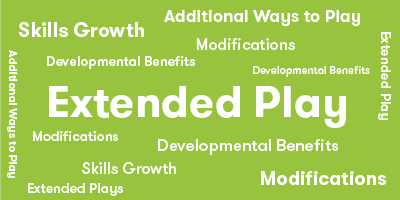
Extra Ways to Play the Game
Have the players subtract instead of add the dragon pirate icons on the islands.
Materials Needed
No additional materials are needed
Developmental Benefits
Subtraction from a product requires a different thinking process, which is slightly more challenging. It requires the player to multiply a product higher than the number on the island, then subtract to get a number that is close to, but not over the number needed.
*Data compiled from CCSSI ELA Standards, WA Science Standards, and Washington Social Studies Standards
Game Details
- 4 Treasure Islands
- 4 Captain Boards
- 20 Island Number Cards
- 16 Treasure Chests
- 16 Bonus Gem Tokens
- 1 Rules Booklet
- Choosing a selection results in a full page refresh.
- Opens in a new window.



















